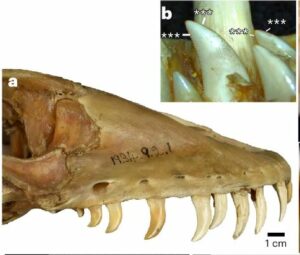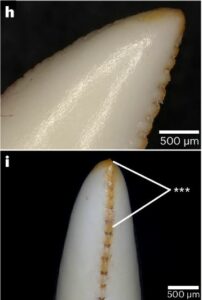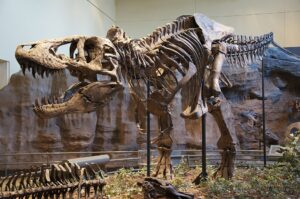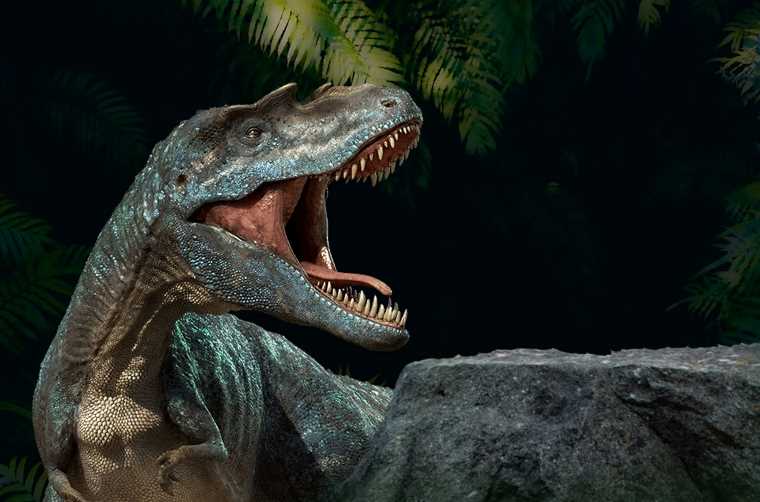Researchers from Kings College London studying Komodo dragons have made a discovery that suggests apex predator dinosaurs, like the notorious Tyrannosaurus Rex, may have had iron-coated teeth that helped them “rip apart” their prey.
While additional study is needed, the research indicates that the presence of iron on the teeth of Komodo dragons helps to keep them sharp, much like metal knives used by humans.
Titled Iron-coated Komodo Dragon Teeth and the Complex Dental Enamel of Carnivorous Reptiles, the study focused on one particular Komodo dragon named Ganas who had lived in a zoo. That effort found that the animal’s teeth were coated in iron. The analysis also found the island predator’s teeth were rather similarly shaped to those of ancient dinosaur predators, leading the researchers to wonder whether those apex predators also had razor-sharp teeth coated in iron.
“Komodo dragons have curved, serrated teeth to rip and tear their prey just like those of meat-eating dinosaurs,” explained Dr. Aaron LeBlanc, lecturer in Dental Biosciences at King’s College London and the study’s lead author, in a press release announcing the research. “We want to use this similarity to learn more about how carnivorous dinosaurs might have ate and if they used iron in their teeth the same way as the Komodo dragon.”


Concentration of Komodo Dragon’s Iron-Coated Teeth Focused Along the Edges and Tips
Published in the journal Nature Ecology & Evolution, the study details how the King’s College researchers “scoured museums” for Komodo dragon teeth. Native to Indonesia, Komodo dragons are the largest known living species of monitor lizards, often weighing up to 80 kilograms (about 176 pounds). As an apex predator, Komodo dragons have razor-sharp teeth that allow them to kill and eat anything from smaller reptiles and birds to full-sized prey like deer, horses, or even water buffalo.
Ultimately, the team was able to procure a set of teeth from a deceased Komodo dragon who had lived at ZSL conservation zoo, London Zoo. Named Ganas, the reptilian predator had lived to the age of 15. Since the average lifespan of a Komodo dragon ranges from 30 to 40 years, this animal died relatively young. Still, these animals typically reach full adulthood by 8 or 9, meaning Ganas was a full-grown adult.
Following a detailed chemical analysis and advanced imaging techniques, the team found a number of interesting details about Ganas’ dental makeup. For example, the team found there was so much iron on the predator’s teeth it actually stained them orange.
“The orange colouration is most intense along serrations closer to the crown tips, whereas the rest of the crown is coated in transparent enamel, making these regions white from the underlying dentine,” the researchers write. “The pigmentation is even more pronounced when using laser-stimulated fluorescence to image both erupted and unerupted teeth, in which the surrounding enamel fluoresces brightly and the pigmented serrations and tips appear dark.”


While the team notes that many other reptiles, including crocodiles, have trace amounts of iron on the surface of their teeth, there is rarely enough for it to become visible.
Perhaps even more intriguing was the concentration of iron along the serrated edges and tips of the Komodo dragon’s teeth. According to the researchers, this location is most likely an evolutionary advantage designed to keep the dragon’s teeth sharp even after repeated use. Although the result was not completely unexpected, study co-author Dr. Benjamin Tapley, Curator of Reptiles and Amphibians at ZSL, said he still regularly finds himself fascinated by these elegant predators.
“As the world’s largest lizards, Komodo dragons are inarguably impressive animals,” said Tapley. “Having worked with them for 12 years at London Zoo, I continue to be fascinated by them, and these findings further emphasize just how incredible they are.”
Study Suggest Dinosaurs Could Have Also Used Iron Coating to Keep Teeth Sharp
During the course of their analysis, the King’s College researchers started to notice similarities between the Komodo dragon’s teeth and fossils of ancient dinosaur predators like T-Rex. Most prevalent was the shape of the curved shape and sharp edges of the teeth. These similarities led the team to wonder if ancient reptilian predators like T-Rex had iron-coated teeth.


Unfortunately, the fossilization of millions of-year-old dinosaur bones has made it impossible for even the most sophisticated modern tools and techniques to determine whether their theory is accurate.
“Using the technology we have at the moment, we can’t see whether fossilised dinosaur teeth had high levels of iron or not,” LeBlanc explained. “We think that the chemical changes which take place during the fossilisation process obscure how much iron was present to start with.”
Offering some hope, LeBlanc noted that science is always evolving. Further study of Komodo dragons may reveal a new way for scientists to test whether dinosaur predators had iron coatings on their teeth.
“With further analysis of the Komodo teeth we may be able to find other markers in the iron coating that aren’t changed during fossilization,” the researcher explained. “With markers like that, we would know with certainty whether dinosaurs also had iron-coated teeth and have a greater understanding of these ferocious predators.”
Study Offered Other Significant Findings
During their analysis of dinosaur tooth fossils, the team made another discovery. It suggested that even if their teeth weren’t coated in iron, these ancient predators appeared to have evolved a whole different way to keep their teeth sharp.
“What we did find, though, was that larger meat-eating dinosaurs, like tyrannosaurs, did change the structure of the enamel itself on the cutting edges of their teeth,” LeBlanc said. “So, while Komodo dragons have altered the chemistry of their teeth, some dinosaurs altered the structure of their dental enamel to maintain a sharp cutting edge.”
In their conclusion, the King’s College research team points out that their work had a number of beneficial results beyond the presence of iron-coated teeth. According to Dr. Tapley, one key discovery is a better understanding of these endangered animals, which may also help efforts to keep them alive for future generations to see and study in person.
“Komodo dragons are sadly endangered, so in addition to strengthening our understanding of how iconic dinosaurs might have lived, this discovery also helps us build a deeper understanding of these amazing reptiles as we work to protect them.”
Christopher Plain is a Science Fiction and Fantasy novelist and Head Science Writer at The Debrief. Follow and connect with him on X, learn about his books at plainfiction.com, or email him directly at christopher@thedebrief.org.

